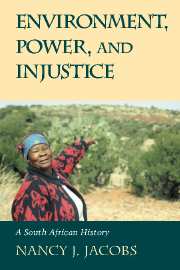Book contents
- Frontmatter
- Contents
- List of Illustrations
- List of Tables
- Preface
- Abbreviations
- 1 Approaching Kuruman
- 2 Goat People and Fish People on the Agro-Pastoral Frontier, c. 1750–1830
- 3 Intensification and Social Innovation on the Cape Frontier, 1820s–1884
- 4 Colonial Annexation: Land Alienation and Environmental Administration, 1884–1894
- 5 Environmental Trauma, Colonial Rule, and the Failure of Extensive Food Production, 1895–1903
- 6 The Environmental History of a “Labor Reservoir,” 1903–1970s
- 7 Apportioning Water, Dividing Land: Segregation, 1910–1977
- 8 Betterment and the Bophuthatswana Donkey Massacre: The Environmental Rights of Tribal Subjects, 1940s–1983
- 9 Retrospectives on Socio-Environmental History and Socio-Environmental Justice
- Appendix A South African Census Statistics on Human Population
- Appendix B South African Census Statistics on Stock Population
- Appendix C1 1991 Individual Interviews
- Appendix C2 1997–1998 Individual Interviews
- Appendix C3 1991 and 1997–1998 Group Interviews
- Appendix D A Note on Archival Sources
- Notes
- Index
8 - Betterment and the Bophuthatswana Donkey Massacre: The Environmental Rights of Tribal Subjects, 1940s–1983
Published online by Cambridge University Press: 05 July 2009
- Frontmatter
- Contents
- List of Illustrations
- List of Tables
- Preface
- Abbreviations
- 1 Approaching Kuruman
- 2 Goat People and Fish People on the Agro-Pastoral Frontier, c. 1750–1830
- 3 Intensification and Social Innovation on the Cape Frontier, 1820s–1884
- 4 Colonial Annexation: Land Alienation and Environmental Administration, 1884–1894
- 5 Environmental Trauma, Colonial Rule, and the Failure of Extensive Food Production, 1895–1903
- 6 The Environmental History of a “Labor Reservoir,” 1903–1970s
- 7 Apportioning Water, Dividing Land: Segregation, 1910–1977
- 8 Betterment and the Bophuthatswana Donkey Massacre: The Environmental Rights of Tribal Subjects, 1940s–1983
- 9 Retrospectives on Socio-Environmental History and Socio-Environmental Justice
- Appendix A South African Census Statistics on Human Population
- Appendix B South African Census Statistics on Stock Population
- Appendix C1 1991 Individual Interviews
- Appendix C2 1997–1998 Individual Interviews
- Appendix C3 1991 and 1997–1998 Group Interviews
- Appendix D A Note on Archival Sources
- Notes
- Index
Summary
It is true that the cattle and the land should be cared for. We are the government's cattle. We give the Government milk. The tax money is the milk. The Government should give green pastures to its cattle otherwise they will dry up.
Forced removal was an obvious and particularly blunt form of state intervention into black people's relations with the environment, but it was not the only aspect of segregation with environmental implications. Blacks who retained their land also suffered a constriction of their rights, including environmental rights, as they became subjects of state intervention. After the 1930s, the state operated conservation programs and became an active and usually unwelcome partner in blacks' relations with the environment. On African reserves, conservation was part of development programs generally known as “Betterment.” Betterment entailed comprehensive and coercive transformations of the ways Africans lived on the land. Initially legislated in 1939 and refined in 1949, it was the policy of “planning” African areas according to the modern principles of agricultural production and conservation science. It characterized African farmers and herders as wastrels destroying soil, forests, and grazing veld. Highly technocratic, Betterment gave officials in the Native Affairs Department (NAD, later the Bantu Administration and Development [BAD] Department) authority to remedy putative abuses by planning land use. It was also intended to support segregation by maximizing the use of communal lands.
- Type
- Chapter
- Information
- Environment, Power, and InjusticeA South African History, pp. 173 - 205Publisher: Cambridge University PressPrint publication year: 2003

